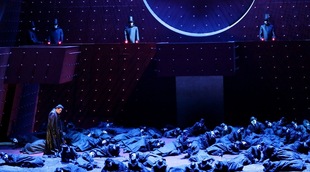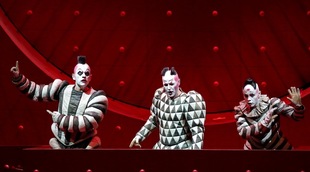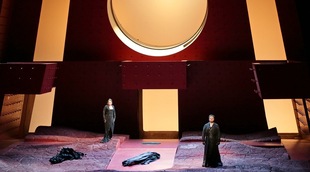 © Teatro alla Scala
© Teatro alla Scala
Turandot started its world-wide successful career from the stage of La Scala in Spring 1926, one and half year after the death of its author. The staging of Puccini’s last and unfinished masterpiece – hailed by a renowned study as “The End of the Great Tradition” of Italian opera – under Toscanini’s baton was a major event. La Scala’s choice to open its special season for Expo 2015 (running non-stop from May 1rst to October 31rst) strikes us therefore as very appropriate and meaningful. As it is the decision to stage the opera with the new ending which Luciano Berio wrote in 2001, replacing the one originally commissioned to Franco Alfano and since then mostly performed (though it was avoided in the première by Toscanini, who interrupted the opera with Puccini’s last bars). The modernity of what is possibly Puccini’s most advanced score is enhanced by Berio’s writing – music of today, yet based (more than Alfano’s) on a wealth of Puccini’s sketches – bridging the 90-year gap between the sensibility of the 1920s and ours. On the whole, La Scala’s successful production, led by principal conductor Riccardo Chailly (who had premièred the Berio version in the Canary Islands in 2002), downplays the opera’s derivation from Italian 19th-century tradition, pushing it towards late-romantic symphonic models and modernist penchant for fairy-tales.

Visually, the audience is presented with the revival of the 2002 Amsterdam staging by German director Nikolaus Lehnhoff, who worked with Chailly and Berio worked just one year before Berio’s demise. A central, fixed structure suggesting Beijing’s historical Forbidden City encloses the action in a blood-red atmosphere, the main, symbolic color of the staging, which makes more vivid and significant any departure from it, such as the moonrise still in Act 1, bathed in a blue light, or in the opening of Act 3, preparing Calaf’s major aria «Nessun dorma». Another major functional as well as symbolic structure is the central giant rose window, situating first Turandot (Act 1) and then the Emperor (Act 2) in an awesome, transcendental distance, while it serves as a poetical setting for the ending of the opera, as a blue light announces the end of the fatal night during the final duet and the two lovers tread towards a horizon finally shining in the sunlight.
The people of Beijing take on a character – one of the most relevant – of their own. The interplay between stage and orchestra pit is in this case particularly effective, with the heads looking as a carpet of flowers turning increasingly menacing and energetic as the choir is lifted to stage level and moves hauntingly up to the end of Act 1, when each chorister brandishes a dagger (a symbol for Turandot’s cruelty, which falls from her hands during the final duet, signifying her capitulation) and the wall turns bright red as Calaf fatally enters the palace. The variety of dynamics entrusted to the choir is remarkable and makes one forget about the overpresent coats (standing for homologation?) which choristers (and even some characters) are forced to wear (quite funny and somehow visually disturbing is the group dressed with top hats, with the hands inside the coats replaced by red lights).
“Apparition” is definitely a keyword in Lehnhoff’s direction: sudden events attract and catalyze the audience’s attention, nonetheless without distracting it from the main action. Just some examples from the opening scene: the entrance of white-dressed Liù and Timur against the dark mass of the crowd and the red walls, the high flame burning in the center of the stage, the imposing naked body, plunged in a pale light, of the Persian prince heading to execution. The scenic rhythm proves particularly effective, successfully blending these abrupt moments in the mainstream of the choral action. Quite opposite is the handling of Berio’s downplayed ending, where the two lovers linger on the desolate stage, a sort of wasteland where they confront each other in a series of poses, until they set off to their common, presumably happy, future, in a sort of suspended ending, an elision deprived of whatever rhetoric («is it over?», asked a lady in front of me after the last bar).

A specific feature of this staging is certainly the handling of the ministers’ trio. Ping, Pong and Pang are no mere accessory to the play. With all the cynicism and witty remarks lent to them by the beautiful libretto by Adami and Simoni, they represent the cruel face of story-tales, where tragedy and comedy grotesquely stand side by side in utmost indifference in front of human grief. It is no chance that they were no Chinese characters, but rather Italian “commedia dell’arte” masks as Tartaglia, Pantalone, Truffaldino and Brighella in Gozzi’s 1762 original “dramatic fairy-tale”, Puccini’s source. Lehnhoff knows this all too well and finds a successful way to avoid both the holographic Chinese costumes and the inhumane mechanical attires we saw in David Pountney’s staging for Salzburg. Lehnhoff conceives the ministers halfway between clowns coming out of a circus and characters taken from a DreamWorks animation movie. The trio gains considerable room in both the first two acts, either in the memorable scene in front of the closed bright red curtain, swollen as a sail, or the light-tone daily-life scene (the only realistic moment of the staging), when the trio sits bored reading newspapers, drinking beer and replacing the dream of the little house in Henan with the more up-to-date poster of a pin-up girl, ending up with a sort of music-hall number at «Non v’è in Cina». In its clownish behaviour the trio occasionally touches a Pierrot-like melancholic mood, which is again quite appropriate to the tragicomic blend of this play. It is a pity that the lively interplay of the three voices (Angelo Veccia, Roberto Covatta, Blagoj Nacoski) sometimes gets lost as they sing towards the back of the stage, or from the balconies on the walls, and occasionally even when they appear at the forestage. Partly because of this, the sequence of changing episodes at the outset of act II, for example, does not flow as natural as it should.
Riccardo Chailly – inaugurating with Turandot an ambitious Puccini cycle, with the complete series of the composer’s 12 operas to be performed at La Scala over the next years – enhances all through the opera the prominence of the orchestra, which is constantly at the forefront, in several ways. The orchestra is responsible, together with La Scalas’ choir, directed by Bruno Casoni, of a gigantic sound which never sounds vulgar but rather grand and solemn, such as at the end of Act 1 or in the second scene of Act 2. In the same scene the orchestra succeeds in offering the sweetest string-sound (right after «Si compia il tuo destino»), then swelling back to very convincing firepower introducing the riddles’ scene («Gli enigmi sono tre»), ending up in the impressive Finale, culminating in a symphonic Coda whose solemnity recalls Mahler’s Symphony – a repertoire of which the Milanese conductor is an acknowledged specialist. On the other hand, Chailly’s constant, loving care for Puccini’s orchestration is quite remarkable in the riddles’ scene itself, as well as in the lyrical moments, when the “voice” of solo instruments comes out in a moving dialogue with the singers, while percussions remain very evident throughout the score. Puccini’s reference to Wagner’s Tristan in the sketches for the final duet apparently represents a stylistic reference for Chailly, and not barely in relation to Berio’s ending. The composer from Lucca is thus firmly established as an international master in his relationships with late romantic Middle-European tradition, from Wagner to Mahler.

The opera was performed by a good cast, which performs flawlessly the demanding show, though not overwhelming the audience with frequent shivers. The most convincing is possibly, as Calaf, Stefano La Colla, replacing on short notice Aleksandrs Antonenko suffering from tracheitis: the tenor showed a beautiful ringing voice, sounding very confident in the role (consider, for example, the peroration from Act 2: «Ti voglio tutta ardente d’amor»), and, even if the diction was not always perfectly clear, his uttering of the key sentences (what Verdi called “parola scenica”) was flawless. In Lehnhoff’s direction Turandot – a problematic character indeed to stage – after appearing towering from a distance in Act 1, creeps like a wild animal out of its lair in both Acts 2 and 3, dressed in a structure which looks like a shell (half animal, half war-machine) and which eventually falls in the final duet, revealing a much more humane evening gown, overtly symbolic of the intimate change in the character’s feelings. Nina Stemme performed her difficult role very naturally and with good versatility: a telling example is her aria from Act 2, where she shifts from the frigid, inexpressive start to the moved recalling of her unhappy ancestor’s fate. While Alexander Tsymbalyuk as Timur offers a warm and always pleasant voice, Liù performed by Maria Agresta, the outstanding Verdian soprano, shows her best in her last scene in Act 3, when she lends the character a most convincing interpretation of heroic love, performing with a blend of resolute, steady singing and intense mezzavoce «Tu, che di gel sei cinta», culminating in the character’s suicide. After Liù’s (and Puccini’s) final lyrical stand, the ensuing funeral procession, with its pulsating, tragic ostinato that gradually becomes more grandiose, seals our lasting impression of the symphonic scale of this opera.
by Raffaele Mellace
the 15 of May, 2015 | Print
Comments